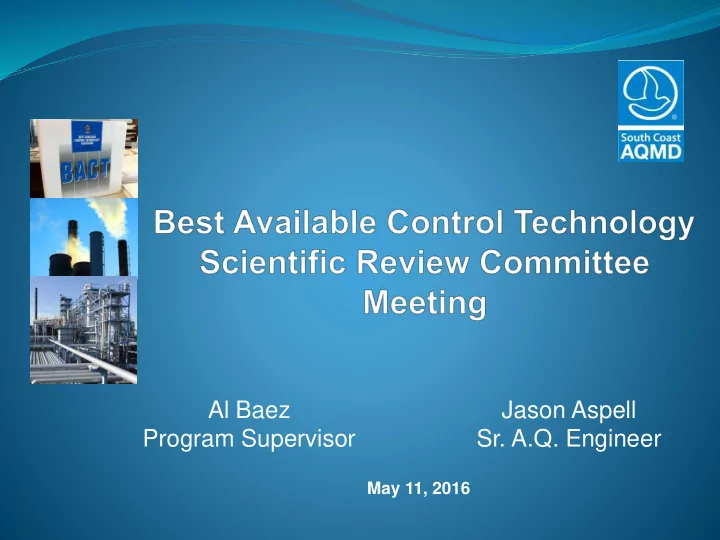

Al Baez Jason Aspell Program Supervisor Sr. A.Q. Engineer May 11, 2016
DISCUSSION TOPICS • Welcome & Introductions • Brief BACT History and Background • Role of SRC • Proposed updates for BACT Guidelines 2
Why is BACT Required? Federal Clean Air Act requires all non- attainment areas to have a New Source Review program for Major Sources. Offsets Modeling Lowest Achievable Emission Rate (LAER) Implemented through Regulation XIII, XVII, XX and BACT Guidelines for major and minor sources California Health & Safety Code 40440.11 3
HISTORY 1979 BACT requirements included in Regulation XIII and requires SCAQMD to publish BACT Guidelines for commonly permitted equipment 1983 BACT Guidelines first published. Major revisions in 1988, 1995, and 1998 1998 SCAQMD Governing Board approves new BACT process and format, SRC 2000 Minor Source BACT adopted 2008 Last amendment of BACT Guidelines 4
BACT Guidelines Format Overview Part A - Policy and Procedures for Major Polluting Facilities Part B - LAER/BACT Determinations for Major Polluting Facilities Section I – AQMD LAER/BACT Determinations Section II – Other LAER/BACT Determinations Section III – Other Technologies Part C – Policy and Procedures for Non-Major Polluting Facilities Part D - BACT Guidelines for Non-Major Polluting Facilities 5
WHAT IS BACT? BACT is the most stringent emission limitation or control technique that is achieved in practice, or contained in a State Implementation Plan (SIP), or technologically feasible and cost effective Technologically feasible and cost effective criterion for non-major sources is unique to SCAQMD which allows for more stringent controls than LAER 6
WHEN IS BACT REQUIRED? Minor Sources SCAQMD Policy: BACT is required for criteria pollutant emission increases ≥ 1.0 lb/day (more stringent for toxic emissions) Rule 1303(a) Major Sources NOx & SOx at RECLAIM facility: Based on increase of maximum hourly potential to emit (Rule 2005) Other criteria pollutants if new daily potential to emit is greater than previous daily potential to emit (Rule 1306 (d)(2)) 7
ACHIEVED IN PRACTICE (AIP) BACT For major source demonstrated by Commercial availability Reliability 6 months operation Effectiveness For minor source demonstrated by H&SC 40440.11 12 months operation Cost Effectiveness Board approval 8
BACT Scientific Review Committee Established in 1995 to increase public participation Made up of members from industry, government agencies, trade organizations, academia and consultants. Review and comment on the appropriateness of proposed new and more stringent BACT determinations Not to comment on past permitting decisions or change them. Meets periodically Reviews revisions to BACT Guidelines 9 9
BACT Guidelines Proposed Updates Overview, Parts A, B, C, D and new Parts E & F (GHG BACT) to maintain consistency with recent changes to SCAQMD rules, State and Federal requirements Intent is for updates that will not result in more stringent requirements than would otherwise occur. Available online at BACT web page 10
Overview updates Hyperlinks on Table of Contents Chapter 1 T-BACT reference BACT Docket info updated Hyperlinks added for web pages and e-mail Chapter 2 Updated map of SCAQMD, Fig. 1 Chapter 3 CO attainment and BACT requirement PSD Requirements Reference to Rules 1420.1 and 1420.2 Chlorobromomethane added to ODCs, Table 2 11
Overview updates (cont’d) Chapter 4 PSD Rules section BACT Docket info updated Hyperlinks added for web pages and e-mail Chapter 5 Background and role of SRC Link to list of current SRC members* 12 12
Major Sources – Parts A & B updates Part A – Policy & Procedures Hyperlinks on Table of Contents Chapter 1 Fed PM 2.5 NSR and Rule 1325 Super “Compliant” Materials Other Considerations Capture Efficiency Pollution Prevention Monitoring and Testing Clean Fuel Requirements - Electrification Part B – LAER/BACT Determinations Continue working with Engineering and Compliance to update listings Flare Oil and Gas Production IC Engine, CI Emergency with DPF 13
Minor Sources Part C – Policy & Procedures Chapter 1 Part D BACT Determinations adoption date clarification Updated Cost Effectiveness values - Marshall & Swift Equipment Cost Index Updated quarterly – no longer published in Chemical Engineering Magazine Top-Down cost methodology Link reference to EPA Control Cost Manual Clean Fuel Requirements “fire suppressant pump ICEs” Updated BACT Update Process flowchart, Fig. 2 Same “Other Considerations” section as Part A Chapter 2 Super “Compliant” Materials Other Considerations – same as Part A 14
Minor Sources (cont’d) Part D – BACT Determinations Hyperlinks on Table of Contents Boiler IC Engine, Stationary, Emergency IC Engine, Portable IC Engine, Stationary, Non-Emergency, Non- Electrical Generators IC Engine, Stationary, Non-Emergency, Electrical Generators Liquid Transfer and Handling Process Heater – Non-Refinery Oil and Gas Production 15 15
Part E – Policy and Procedures for Facilities Subject to PSD for Greenhouse Gases (GHG) Regulation XVII applicability – Prevention of Significant Deterioration Facilities are subject to GHG BACT if: New or Modification of existing source increase potential to emit by 100 or 250 tons/year depending on source category; and Have potential to emit >75,000 tons/year of carbon dioxide equivalent (CO 2e ) Must be subject to PSD for a pollutant other than GHG Tailoring Rule undergoing revision - U.S. Supreme Court decision in Utility Air Regulatory Group v. Environmental Protection Agency, 134 S. Ct. 2427 (2014) . 16 16
Part F – BACT Determinations for Facilities Subject to PSD for GHG Work in Progress EPA Guidance emphasizes options that improve energy efficiency and possibly biomass Carbon Capture and Sequestration may be considered but likely cost prohibitive Potential impacted sources include: Electricity Generation Large industrial/commercial boilers Cement industry Refineries Iron and Steel industry 17
List of Abbreviations & Index of Equipment Categories Included new or previously omitted terms Changed title to “List of Equipment Categories” Updated categories 18 18
Other Business Next Steps 30-Day Review for comments Develop Board Letter package Stationary Source Committee Targeting July/August Board Approval Future updates AB1234 Ethics Training www.fppc.ca.gov (free on line course) Revised BACT Determination Form Date of next meeting 19 19 19
SCAQMD’s BACT Guidelines www.aqmd.gov/home/permits/bact Al Baez, Program Supervisor abaez@aqmd.gov Jason Aspell, Sr. AQ Engineer jaspell@aqmd.gov 20
Recommend
More recommend